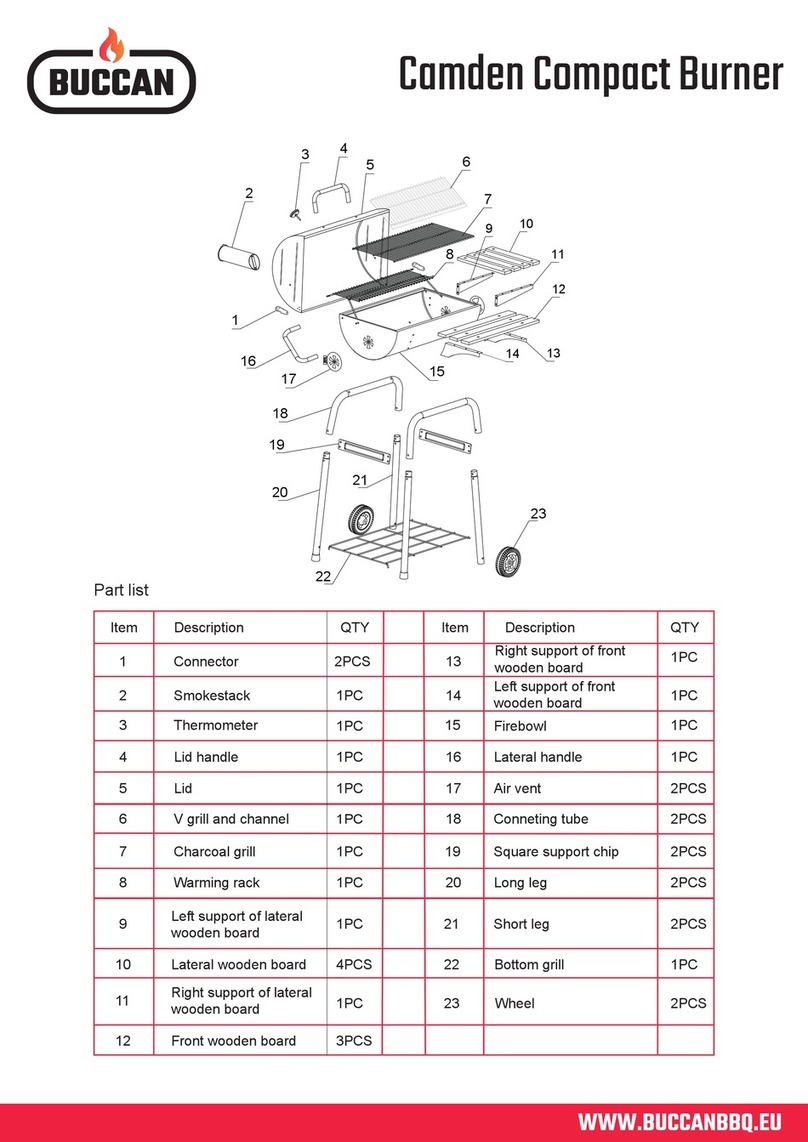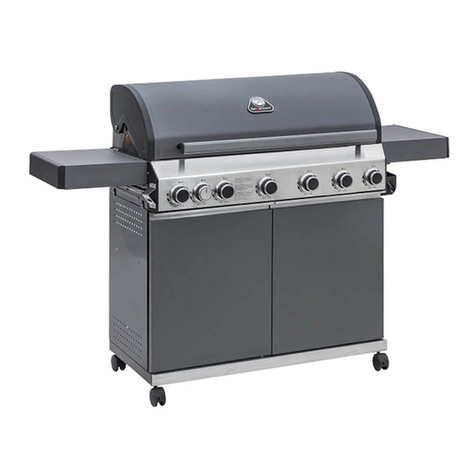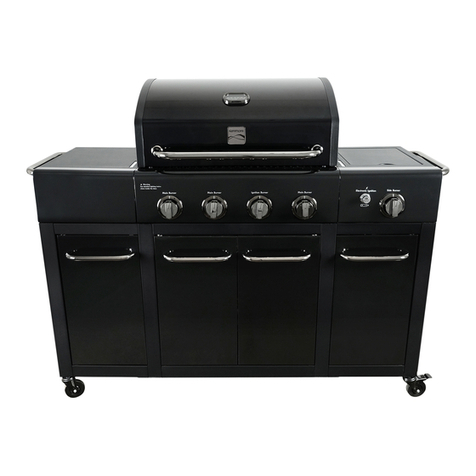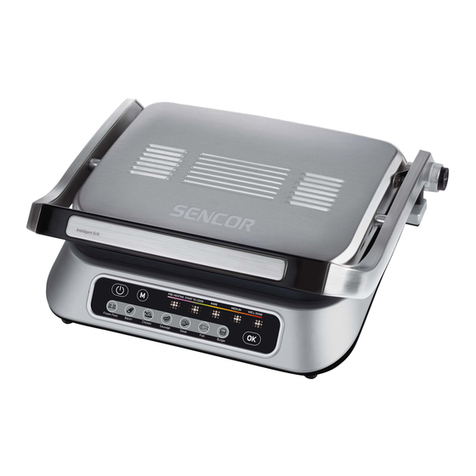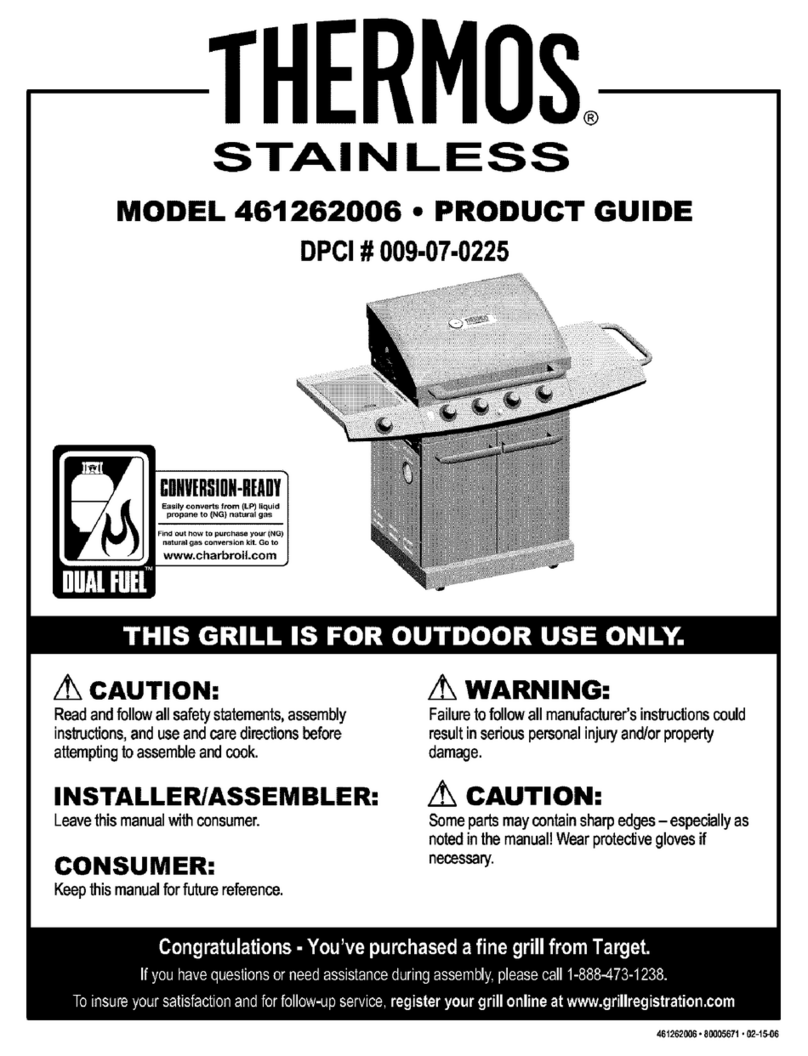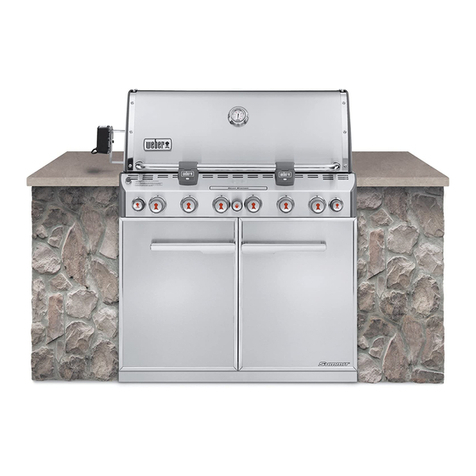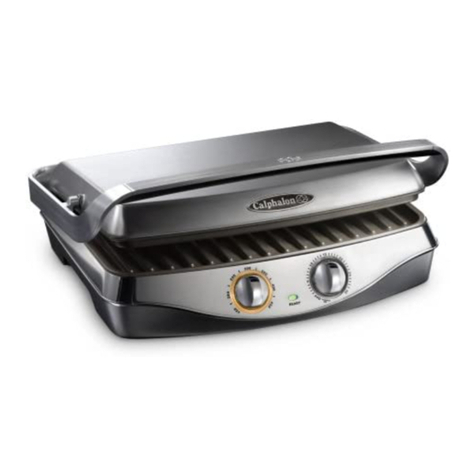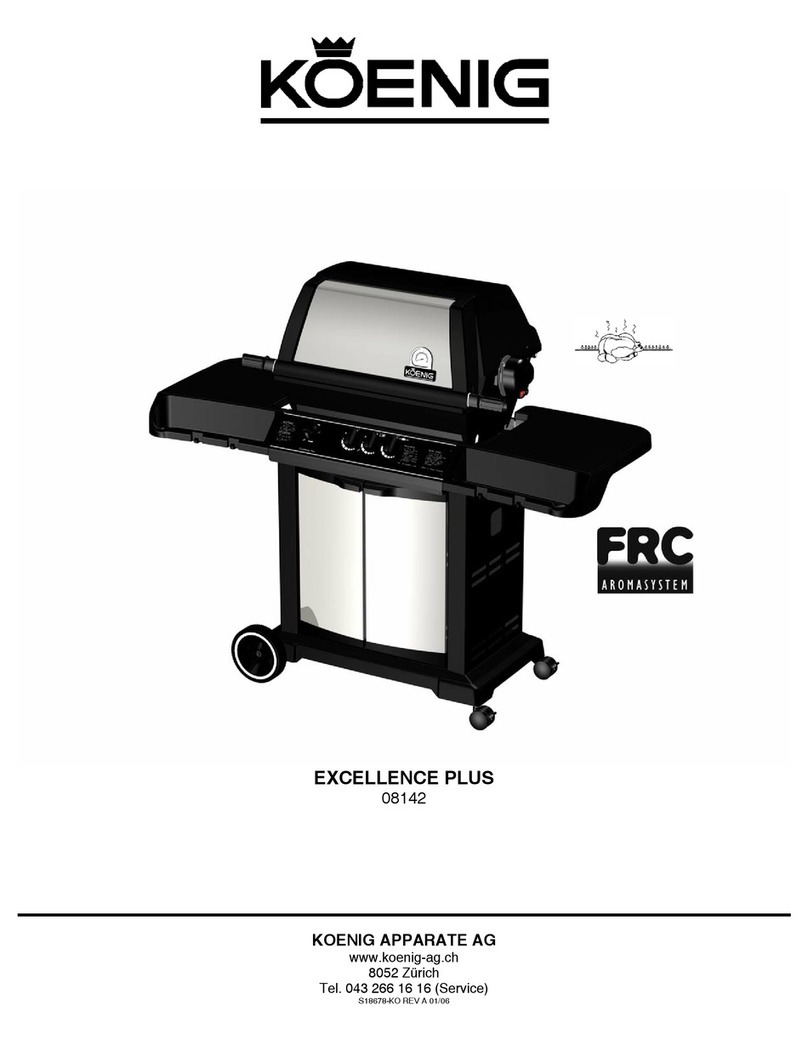Ningbo Agsun Products K113-4BFI3 User manual


1
FOR FUTURE REFERENCE
IMPORTANT: PLEASE READ AND UNDERSTAND ALL INSTRUCTIONS AND OPERATIONS
BEFORE OPERATING THIS UNIT. FOLLOW ALL STEPS IN ORDER. NEVER ALLOW
CHILDREN TO OPERATE THIS UNIT. SAVE THESE INSTRUCTIONS FOR FUTURE
REFERENCE. THIS GAS GRILL IS DESIGNED FOR OUTDOOR USE ONLY.
Warnings:
•Only to be used outdoors.
•Read the instructions before using the appliance.
•Accessible parts maybe very hot - keep young children away.
•Do not move the appliance during use.
•Turn off the gas supply at the gas container after use.
•Any modification of the appliance may be dangerous.
•Parts sealed by the manufacturer or his agent must not be altered by the user.
Attention:
Some parts of this appliance become very hot; take special care when children or elderly are present.
For your safety:
•Do not store or usegasoline, methylated spirits or any other flammable vapors and liquids in the vicinity
of this or any other appliance.
•Never attempt to light a gas grill with gasoline or comparable fluids!
•Do not attempt to adjust or alter any factory-sealed assemblies.
1. Technical data
Model: K113-4BFI3

2
2. Exploded View
1
2
3
4
5
6
7
8
9
10
11
12
13
14
15
16
17
18
19
20
21
22
23
24
25
26
27
28
29
30
31
32

3
3. Parts list
Item
No.
Description
Qty
Item
No.
Description
Qty
1
Main Lid
1
2
Temperature Gauge
1
3
Main Lid Handle
1
4
Warming Rack
1
5
Cast Iron Grid
2
6
Flame Tamer
3
7
Main Burner
4
8
Grease Tray
1
9
Grease Tray Bracket
1
10
Grease Cup
1
11
Cylinder Hook Reinforcing Plate
1
12
Cylinder Hook
1
13
Side table right back support
bracket
1
14
Right side table
1
15
Cabinet left side panel
1
16
Cabinet front beam
1
17
Cabinet Back Panel
1
18
Cabinet right side panel
1
19
Cabinet Bottom Panel
1
20
Cabinet triangle bracket
2
21
Swivel Caster
4
22
Control Panel
1
23
Gas valve and tube assy
1
24
Control Knob
5
25
Door
2
26
Side burner gas valve
1
27
Side Burner
1
28
Side burner insert tray
1
29
Side Burner Grid
1
30
Side table left back support
bracket
1
31
Cast Iron Plate
1
32
Firebox
1
4. Fastenings
5. Assembly steps
Follow these instructions carefully to ensure the correct and safe assembly of the grill.
CAUTION: Although we take every effort to ensure that the assembly process is as easy as possible, it is
inherent with fabricated steel parts that corners and edges can cause cuts if improperly handled during
assembly procedures. Be careful while handling any parts during assembly. It is strongly recommended that
you protect hands with a pair of work gloves.
A B C
X11
5/32-32
X18
1/4-20
X2 X4
D

4

5
4 x B

6
AX4

7
4 x B
5x B
2x D

8
4x A
5x B
2x D

9

10
1x A
2 x C

11
2 x A

12

13

14

Important Information
Please read these instructions fully before
using the appliance.
•Assembly time: approx. 50 mins. Assistance will
be required for some steps.
•Retain these instructions for future reference.
•Use outdoors only.
•Do not use the barbecue, or store gas bottles,
below ground level. LP gas is heavier than air so if
a leak occurs the gas will collect at a low level and
could ignite in the presence of a flame or spark.
•For use with LPG bottled gas only. A suitable
regulator must be used for LP gas.
•Remove all plastic wrap from parts before lighting.
•Do not use within 1m of any flammable structure or
surface. Do not use under any combustible
surface.
•LP gas cylinders should never be placed directly
underneath the barbecue.
•LP gas cylinders should never be stored or used on
their side, in the horizontal position. A leak would
be very serious and liquid could enter the gas line
with serious result.
•Never store gas bottles indoors.
•Do not move the appliance during use.
•Open the barbecue hood before lighting.
•Do not move the barbecue until it has completely
cooled after use.
•This barbecue must not be left unattended when lit.
•The hood handle can become very hot. Grip only
the centre of the handle. Always use oven gloves
when cooking or carrying out any adjustments to
the barbecue.
•Use purpose designed barbecue tools with long
and heat resistant handles.
•Use caution when opening the hood, as heat and
steam inside will be released upon opening.
•Warning: accessible parts may be very hot. Keep
young children away.
•Turn off the gas supply at the gas cylinder after
use.
•Never cover a barbecue until it has completely
cooled.
•Use this barbecue only on a non-combustible,
stable and flat surface
•Before using this barbecue, perform a leak test.
This is the only safe and sure way to detect any
gas leaking from joints and connections of the
barbecue after assembly.
•Leak test annually, and whenever the gas bottle is
removed or replaced.
•Do not store flammable materials near this
barbecue.
•Do not use aerosols near this barbecue.
•Failure to follow the manual’s instructions could
result in serious injury or damage.
•Do not modify the appliance. Modification of this
barbecue may be dangerous, is not permitted and
will nullify any warranty.
•This appliance must be kept away from flammable
materials during use.
•All the parts sealed by the manufactured or his
agent shall not be adjusted or altered by the user.
•If you have any queries regarding these
instructions, contact your local dealer.
Gas, Regulator and Hose
This BBQ is for use with NZ LPG only. Check that you
have the correct gas bottle type for use with the
regulator supplied with the BBQ.
•The hose should hang freely with no bends,
twisting, tension, folds, or kinks that could obstruct
free flow of gas. Always inspect the hose for cuts,
cracks, or excessive wear before use.
•Apart from the connection point, no part of the hose
should touch any hot barbecue parts. If the hose
shows any sign of damage it must be replaced with
an Approved hose suitable for use with LP gas.
Never mount the gas bottle under the barbecue on the
base shelf, as this could result in serious injury to the
user, other people and/or property. Always place the
gas bottle at the side of the appliance. The gas
bottle should be sited as far away from the
appliance as possible without straining the hose.
This appliance is only suitable for use with LPG and
fitted with the appropriate low-pressure regulator via a
flexible hose.
Check your hose and regulator closely, at least

annually, for any signs of damage, cracking or splits
due to aging especially if the barbecue is stored
outdoors. It is strongly recommended that the hose and
regulator be replaced at least every 5 years to avoid
failure due to aging.
Please consult your dealer for information regarding a
suitable regulator and hose if a replacement is needed.
Installation
Selecting a Location
This barbecue is for outdoor use only and should be
placed in a well-ventilated area, and on a safe and
even surface. Never place your barbecue below
ground level or under flammable materials such as
wooden structures or trees. Ensure that the barbecue
is used on a non-combustible floor. The sides of the
barbecue should NEVER be closer than 1 metre from
any combustible surfaces including trees, walls and
fences, and make sure that there are no heat sources
near the barbecue (cigarettes, open flames, sparks,
etc.) Keep this barbecue away from any
flammable materials!
Precautions
Do not obstruct any ventilation openings in the
barbecue body. Position the gas cylinder on level
ground next to the barbecue and safely away from any
source of heat. Should you need to install or change
the gas cylinder, confirm that the barbecue is switched
off, and that there are no sources of ignition (cigarettes,
open flame, sparks, etc.) nearby before proceeding.
Fixing a Regulator to the Gas Cylinder
Must be done outdoors in a well-ventilated area.
Confirm all barbecue control knobs are in the OFF
position. Connect the regulator to the gas cylinder
according to your regulator’s and cylinder dealer’s
instructions.
Leak Testing (Always perform a leak test in
a well-ventilated area)
Confirm all control knobs are in the off position. Open
the gas control valve on the gas cylinder or regulator.
Check for leaks by brushing a solution of ½ water and
½ liquid detergent or soap over all the gas system
joints, including gas cylinder valve connections, hose
connections, and regulator connections. NEVER USE
AN OPEN FLAME to test for leaks at any time. If
bubbles form over any of the joints there is a leak.
Turn off the gas supply at the gas cylinder. Retighten all
joints. Repeat test. If bubbles form again do not use the
barbecue and contact your local distributor for
assistance. Always wipe the mixed solution (½ water
and ½ liquid detergent or soap) from all joints and
connections after leak testing to prevent possible
corrosion.
Operation
Warning
•Before proceeding, make certain that you have
read and understood the IMPORTANT
INFORMATION section of this manual.
•Your barbecue is not designed to be used with
more than 50% of the cooking area as a solid plate
—this includes baking dishes. Full coverage will
cause excessive build-up of heat and damage the
barbecue. This is not covered by warranty.
Preparation Before Cooking
To prevent foods from sticking to the cooking surface,
use a long-handled brush to apply a light coat of
cooking or vegetable oil before each barbecuing
session. (Note: When cooking for the first time, paint
colours may change slightly as a result. This is normal
and should be expected.) During use, the protective
coating may come off the cooking surface. This is
normal and is not harmful. Line the Grease Tray with
aluminium foil, but do not obstruct the drainage hole
through to the Grease Box. This will make clean-up
easier.
Lighting the Main Burners
•Always open the hood of the barbecue before
lighting. Do not stand with your face directly over
the barbecue.
•Ensure all gas controls on the barbecue are turned
to the OFF position and then slowly open the
cylinder valve (anti-clockwise) 1 ½ turns. If the
valve jams, try closing the valve first. It may have
been left open previously. NEVER try to open the
valve with a wrench.

Your barbecue may have one or more of the following
ignition methods:
Pilot Gas Control Ignition
Push in the gas control knob and hold for 3-5 seconds
to allow gas flow, and then turn anti-clockwise to HIGH.
You will hear and feel a click, and sight a 75-100mm
flame alongside the burner. Continue to hold the
control in for 2-3 seconds after the click. This will
allow gas flow completely down the burner and ensure
ignition. Release the control knob.
Turn on adjacent gas controls and their burners will
cross-light from the initial burner.
At HIGH, the burner flame should be 12-20mm long
with a minimum of yellow tipping.
Turn the control knob fully anticlockwise for minimum
heat setting.
Warning: If the burner does not light, turn the
control knob to OFF and wait 5 minutes for gas
to clear before repeating the lighting
procedure.
After the main burners are lit, allow the barbecue to run
for 3-5 minutes to pre-heat before starting to cook.
This should be done before each cooking session.
The hood should be open when pre-heating.
Once cooking is started the burners should be turned
down to a lower setting for best results.
Side burner ignition
Push in the gas control knob and turn anti-clockwise
until a slight resistance to turning is felt. Hold for 3-5
seconds to allow gas flow and then turn to HIGH. You
will hear and feel a click, and sight a spark alongside
the side burner cap which should ignite the burner. If
the burner doesn’t light, turn the control to OFF and
repeat.
At HIGH, the burner flame should be 10-15mm long
with a minimum of yellow tipping.
Turn the control knob fully anticlockwise for minimum
heat setting.
Warning: If the burner does not light, turn the
control knob to OFF and wait 5 minutes for gas
to clear before repeating the lighting
procedure.
The side burner is best suited to flat-bottomed pots and
pans of 20-24cm size. Always use a lid on the pot or
pan if possible, for most efficient heating.
Manual Ignition of burners
If required, the barbecue burner can be lit manually.
Important - to avoid possible burn injury, use a long
match, or an extended-reach gas lighter only –do not
use a normal match or cigarette lighter.
Push and turn the gas control to HIGH, while holding
the lit match or lighter alongside the appropriate burner.
Adjacent burners should then cross-light as their
controls are turned on.
Should you have difficulty in lighting your barbecue
while following these instructions, please contact your
dealer for advice.
Grill Cooking
The burners heat up the flame tamer underneath the
grill, which in turn heats the food on the grill. The
natural food juices produced during cooking fall onto
the hot flame tamer below and vaporise. The
subsequent rising smoke bastes the food, as it travels
upwards, imparting that unique barbecued flavour.

Roasting Hood Cooking
Barbecues equipped with a roasting hood give the
option to form an ‘oven’ for roasting or baking food,
such as joints of meat or whole chickens, etc. More
even cooking of food will actually be achieved by using
the barbecue with the hood down. However, this
should only be done with the burners on low.
For best results, place the food you wish to bake or
roast on a metal baking tray and set it on one side of
the cooking grill.
Turn the burner directly under the food to the OFF
position and turn all other burners to a LOW to
MEDIUM position.
Close the hood to cook the food ‘indirectly’. Avoid
lifting the hood unnecessarily as heat is lost every time
the hood is opened. If the hood is opened during
cooking please allow extra time for the barbecue to
regain its temperature and complete the cooking. Use
the temperature gauge (if applicable) to monitor the
heat of the barbecue.
If the internal heat becomes too high, turn the burners
down to the low position. It is not necessary, nor
advisable, to have all of the burners on high when the
hood is closed.
DO NOT ALLOW YOUR BARBECUE TO OVERHEAT.
Take care when opening the hood as heat and steam
will be released on opening.
Flare-up Control –VERY IMPORTANT
Flare-ups occur when meat is barbecued, and its fat
and juices fall upon the hot flame tamer. Smoke of
course helps give food its barbecued flavour, but it is
best to avoid excessive flare-up to prevent food being
burned. To control flare-ups, it is ABSOLUTELY
ESSENTIAL to trim away excess fat from meat and
poultry before grilling, use cooking sauces and
marinades sparingly, and try to avoid very cheap cuts
of meat or meat products as these tend to have a high
fat and water content. Also, the burners should always
be placed on the low setting during cooking.
When flare-ups do occur, they can usually be
extinguished by applying baking soda or salt directly
onto the flame tamer. Always protect your hands when
handling anything near the cooking surface of the
barbecue and take care to protect yourself from the
flames.
If a fat fire occurs, please see the instructions given
below.
Fat Fires
Empty and clean the drip tray, of food debris after each
cooking session. If the barbecue is to be used for large
gatherings, it will be necessary to turn off and cool the
barbecue every two hours to remove food debris from
the drip tray, and clean it out. The time between
cleaning may need to be reduced if very fatty foods or
cheap meat products are being cooked. Failure to do
this may result in a fat fire, which may cause injury and
could seriously damage the barbecue.
In the event of a fat fire
•Turn off the gas supply at the gas cylinder valve.
•If safe to do so, turn all control knobs to the OFF
position.
•Keep everyone at a safe distance from the
barbecue and wait until the fire has burnt out.
•Do not close the hood or lid of the barbecue.
•NEVER DOUSE A BARBECUE WITH WATER. IF
AN EXTINGUISHER IS USED, IT SHOULD BE A
POWDER TYPE.
•DO NOT REMOVE THE DRIP TRAY.
•If the fire does not seem to be abating or appears
to be worsening, contact your local Fire Brigade for
assistance.
End of Cooking Session
After each cooking session, turn the barbecue burners
to the “high” position and burn for 5 minutes. This
procedure will burn off cooking residue, thus making
cleaning easier. Make sure the hood is open during
this process.
Turning Off Your Barbecue
When you have finished using your barbecue, turn off
the gas supply at the gas cylinder and then when the
burners go out, turn off all the gas control knobs.
Wait until the barbecue is sufficiently cool before
closing the hood or lid.

Care and Maintenance
Regularly clean your barbecue between uses and
especially after extended periods of storage. Ensure
the barbecue and its components are sufficiently cool
before cleaning. Do not leave the barbecue exposed to
outside weather conditions or stored in damp, moist
areas.
•Never douse the barbecue with water when its
surfaces are hot.
•Never handle hot parts with unprotected hands.
In order to extend the life and maintain the condition of
your barbecue, we strongly recommend that the unit be
covered when left outside for any length of time,
especially during the winter months.
Even when your barbecue is covered for its protection,
it must be inspected on a regular basis as damp or
condensation can form which may result in damage to
the barbecue. It may be necessary to dry the barbecue
and the inside of the cover. It is possible for mould to
grow on any fat remaining on parts of the barbecue.
This should be cleaned off smooth surfaces with hot
soapy water.
Any rust that is found that does not come into contact
with the food should be treated with a rust inhibitor and
painted with barbecue paint or a heat resistant paint. A
chrome cleaner may be used on plated parts if required.
To prevent rusting, wipe plated parts with cooking oil
after rinsing and drying.
Cooking surfaces
When the barbecue has cooled, clean with hot soapy
water. To remove any food residue, use a mild cream
cleaner on a non-abrasive pad. Do not use scouring
pads or powders as they can permanently damage the
finish. Rinse well and dry thoroughly. Due to the weight
of the cooking surfaces, we do not recommend
cleaning in a dishwasher.
It is quite normal for surface rust to be present on the
cooking surface. If rust appears between uses or in
storage, clean with a soft brass wire brush, re-oil and
cure. Be careful not to damage the cooking surface.
Burner
Provided that they are operating correctly, in normal
usage, burning off the residue after cooking will keep
the burners clean.
The burners should be removed and cleaned annually,
or whenever heavy build-up is found, to ensure that
there are no signs of blockage (debris, insects) in either
the burner portholes or the primary air inlet of the
burners. Use a pipe cleaner to clear obstructions.
When refitting the burners, be careful to check that the
neck of the burner fits over the valve outlet. Refit the
circlips holding the burners.
It is quite normal for some surface rust to be present on
the burners. If rust appears between uses or in storage,
clean with a soft brass wire brush.
Burners do deteriorate with use - this is normal.
Periodic replacement may be needed.
Flame Tamer
Remove any food residue from the flame tamer surface
with a plastic or wooden scraper or brass wire brush.
Do not use a steel scraper or wire brush. Clean with hot
soapy water and rinse well.
Flame tamers will deteriorate with use - this is normal.
Periodic replacement may be needed.
Drip Tray
After every use, empty and clean the drip tray of any fat
or food particles, using a plastic or wooden scraper if
necessary.
Failure to keep it clean, or excessive grease build up in
use, can result in a fat fire. This can be hazardous and
severely damage the barbecue. This is not a fault in the
barbecue and is therefore not covered by the terms of
the warranty. If required, the tray can be washed in hot
soapy water, rinsed, dried and replaced in the
barbecue.
Barbecue Body
Regularly remove excess grease or fat from the
barbecue body using a cloth wrung out in hot soapy
water and dry thoroughly. Excess fat and food debris
can be removed from inside the body using a soft
plastic or wooden scraper. It is not necessary to
remove all the grease from the body. If you need to
clean fully, use hot soapy water and a cloth, or
nylon-bristled brush only. Do not use abrasives.
Remove cooking surfaces and burners before full
cleaning. Do not immerse the gas controls or manifold
in water. Check burner operation after carefully refitting
into body.
Table of contents


